Ala-Kul Lake, nestled high in the Tien Shan mountains of Kyrgyzstan, is one of the region’s most breathtaking natural wonders. Perched at an altitude of 3,560 meters (11,680 feet), the lake is renowned for its striking turquoise waters, which change hues with the shifting sunlight. Surrounded by rugged peaks and glaciers, Ala-Kul is accessible only via a challenging multi-day trek, making it a rewarding destination for adventurers. The lake’s name translates to “Motley Lake,” a nod to the vivid colors of its surface, which reflect the surrounding landscapes. For trekkers, reaching Ala-Kul is not just about the destination—it’s about the journey through alpine meadows, roaring rivers, and remote mountain terrain.
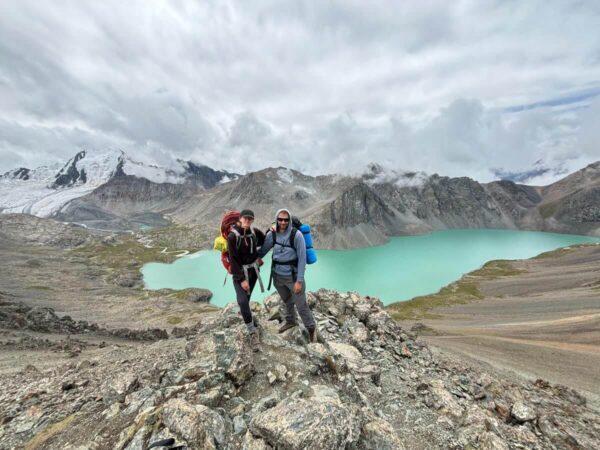
We first heard about this spectacular lake four days before beginning our trek toward it. This was when we abandoned our last hope of receiving the Tajikistan visa we had applied for weeks earlier, forcing us to cancel our plan to trek the Fann Mountains. Searching for alternative destinations for a multi-day trek in Kyrgyzstan that required minimal planning and no climbing gear, we soon stumbled upon Ala-Kul. It looked perfect.
Two days later, after covering some 1300 km from eastern Uzbekistan, we arrived in Karakol—the gateway to the Tien Shan Mountains in Kyrgyzstan. Spending a few extra days in town for basic preparations and a bit of exploration, we were ready to begin our journey.
As I mentioned, the trek to Ala-Kul Lake involves no technical difficulties. Its immense popularity, entailing facilities like yurts for rent and food available en route, makes it even more accessible. With a good off-road vehicle to bring you all the way to the trailhead, it’s even possible to reach Ala-Kul as part of a single-day round trip.
For our trek, we chose the popular circuit starting in Karakol and ending in Ak-Suu. The route took us along the full length of the lake and over the Ala-Kul Pass at an elevation of 3,920 meters. We carried our own tent and food, though most hikers we encountered lightened their load by staying in yurts along the way. Taking a leisurely pace and spending two nights by the lake to fully immerse ourselves in its beauty (perhaps a bit too fully as you will read), the entire trip lasted six days.
Affiliation disclosure: By purchasing goods or services via the links contained in this post, I may be earning a small commission from the seller's profit, without you being charged any extra penny. You will be thus greatly helping me to maintain and keep enriching this website. Thanks!
Following is my trip report, where you will find lots of practical information if you intend to do something similar. If, on the other hand, you decide to experience this majestic trek in a more organized and relaxed manner, make sure to check out this tour.
Day #1 Karakol to Sirota Camp
We left our lovely homestay (highly recommended if you’re looking for an economical, welcoming place) at 9:00 am. Most people hire 4×4 cars to reach as close to the trailhead as possible. We were in no rush and called an ordinary 2WD Yandex taxi that brought us to the furthest point it physically could for 500 som. That was a wooden bridge beside Aydin-Kol Yurt Camp, from where we had to walk 12 km of rough dirt road and gain 500 meters of altitude to the trailhead. Before that point, we drove past a checkpoint and paid an entrance fee of 300 som per person plus 200 for our tent.
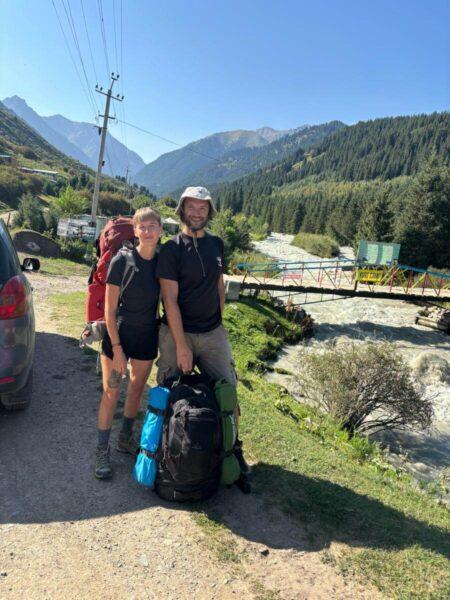
By 9:30 am, we began hiking along the rushing river, often in the relieving shade of conifer forests. Jeeps were overtaking us continuously, transferring hikers higher up the mountain. Horses and cows attended us nonchalantly. After the initial steeper part, we emerged into a flat, open valley, where the river calmed and rugged peaks appeared in the distance, composing a painting-worthy scenery. Three hours after our morning start, we reached the trailhead (location) beside Alplager Karakol.
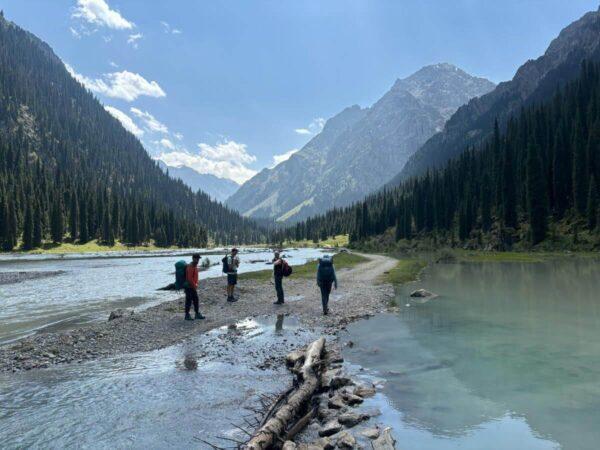
An old Soviet military truck stood parked there, repurposed into a canteen. We bought some coffee and biscuits to complement our self-made lunch. Considering the effort required to transport supplies up there, the markup wasn’t too steep. After a brief rest, we crossed the bridge and set off on the trail.
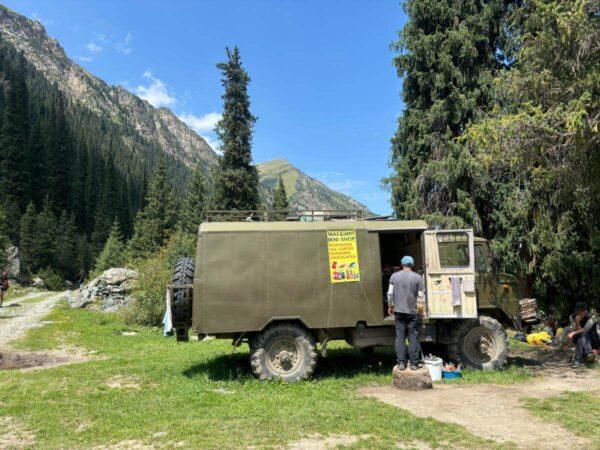
Birdsong echoed through the charming forest now that the river’s roar had faded into the distance. From every clearing, the views of celestial peaks and the valley below grew increasingly jaw-dropping. Along the way, we passed numerous other hikers and several travelers on horseback. The trail, though steep, was manageable. In about an hour, we ascended the 400 meters to reach Sirota Camp.
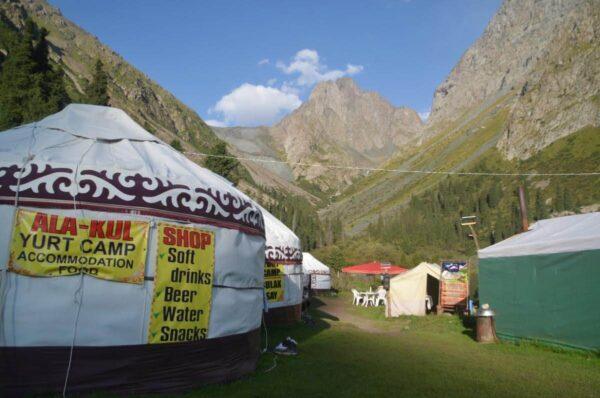
We had been open to the prospect of pushing on to Ala-Kul on the same day, but we changed our minds as soon as we witnessed the allure of the ambiance. Dramatic yet serene, Sirota Camp was nestled beside a small, sapphire-blue lake, encircled by majestic mountains and towering evergreens whose branches whispered a constant soothing tune as they danced in the breeze.
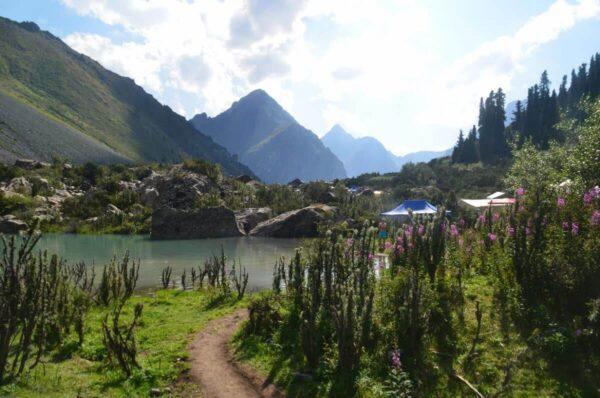
The area was quite crowded, mostly with groups from organized tours staying in the yurts, but we managed to secure a good spot for our tent by the shore. After a refreshing dip in the freezing lake, we spent the rest of the afternoon relaxing and dined in the kitchen tent alongside a friendly group of American and Slovene hikers. Since the food price wasn’t too steep at the yurts (800 som, bargained down from 1000), we decided to save our own provisions in case we wanted to extend our trip. We went to bed early and rose with the first light of dawn.
Day #2 Sirota Camp to Ala-Kul Lake
Duly dallying in the morning, we were among the last to set off for the lake by 10:40 am. The route was beautiful but strenuous. With one long break by a thundering waterfall before the last, steepest section, we arrived at the shore of Ala-Kul by 13:35, breathless but brimming with awe.
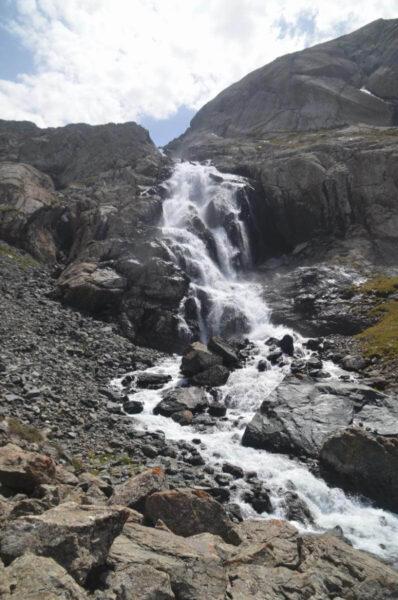
In the afternoon sunshine, the lake was a shimmering jewel cradled by the rugged peaks of the Tien Shan mountains. The turquoise waters, so vivid they seemed almost otherworldly, took on a dreamlike hue as the golden light danced across the surface. Shadows from the jagged ridges and wandering clouds stretched long and dramatic, framing the lake in a theater of light and dark. The stillness of the alpine air was interrupted only by the rumble of the outlet stream and the occasional whistling of a gust.
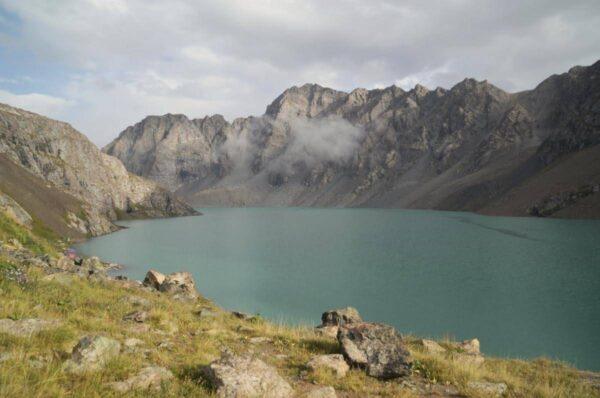
The organized campsite is located on the northern shore of the lake, offering large tents with beds, food, and even paddleboards for rent. Seeking more privacy, we settled at the lake’s western edge. Our chosen spot, sheltered by a cairn wall, was perfectly situated—close enough to the shore for easy access to water yet high enough to enjoy sweeping views of the surroundings.
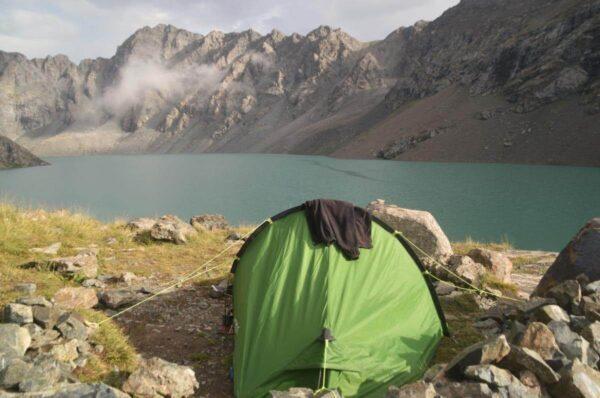
We got comfy and made food right on time before the rain started. It wouldn’t stop until late tomorrow morning.
Day #3 All Day at Ala-Kul Lake
Rain and thunder raged all night long. The depression beneath our tent became a puddle, and the floor quickly began filling with water. At its worst, just before dawn, our mats felt like two small floating rafts. It was a taxing experience.
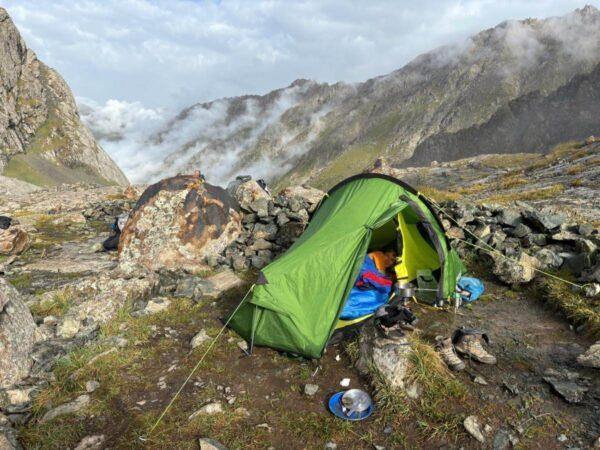
The sun slyly made a tentative appearance between the swirling clouds at some point in the morning. It fooled us to hope for a fair day. If we’d been smart, we would have taken advantage of that brief spell—dried off, packed up, and gotten the fuck out of there. But since I was fixated on the idea of taking those two acid tabs I had with me in this marvelous setting, and I was also paranoid of them losing their potency if I keep carrying them around much longer, we decided to stay.
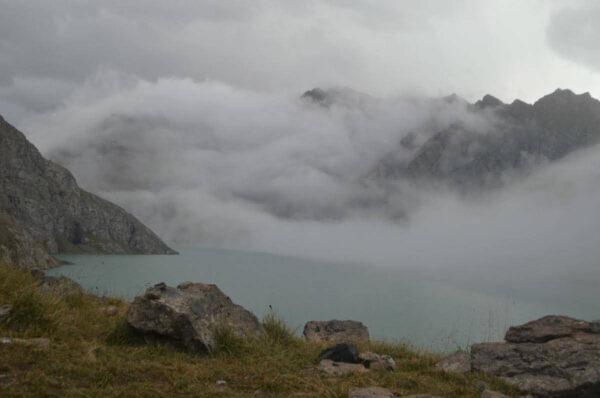
We spread all our wet stuff out wide to dry, had some breakfast, and took the tabs. My arse they were going to lose potency. They laucnhed our minds out of our skulls and onto the edge of space-time. As existence began to feel really weird, the rain broke again. We spent the entire day tripping inside the tent, staring at the animated lake and the fluid, uncanny rocks out of the door. During spells of drizzling, we drifted around in circles, lost in the surreal beauty.
Day #4 Past Ala-Kul Pass to Altynarasan Camp Nochlezhka Campground
After a few hours of restless, lucid sleep, we woke up in the same soaked tent. Around us, the rain-pelted, desolate landscape lay unnervingly still. At the first easing of the rain, we packed everything in a flash and bolted, desperate to escape that godforsaken place.
After all, the rain didn’t return, and we even enjoyed fleeting intervals of sunshine. Marmots emerged from their burrows, basking in the warmth on the rocks. We skirted the headland on the north shore and, for the first time, saw the eastern, greater expanse of Ala-Kul Lake. Towering peaks and glaciers loomed dramatically above the far end. The slope before Ala-Kul Pass was tough, but the panoramic vista of the entire lake from the top was utterly rewarding.
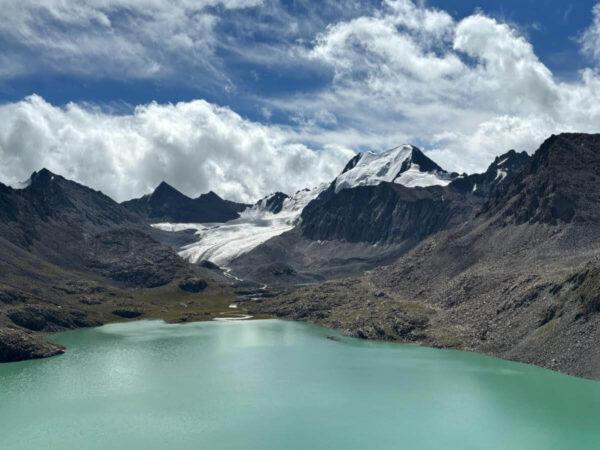
The slope behind the pass was brutally steeper. I felt fortunate not to be among the handful of hikers tackling it in reverse. At the bottom lay a rather large yurt camp where many people arrived on horseriding tours. We had a little break by a refreshing brook and continued.
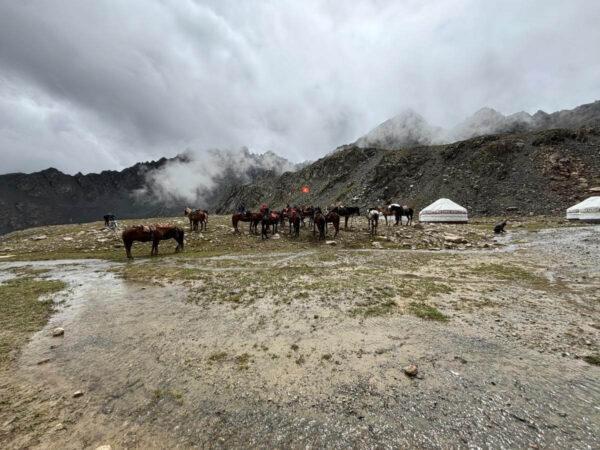
Our plan was to head straight to Altynarasan Camp, and we had plenty of time to get there. But exhaustion had set in, and Sophie wasn’t feeling well, so we decided to call it a day at a pleasant campsite called Nochlezhka (located here). To avoid sleeping in water again if another storm hit, we pitched our tent on a raised hump of ground. The sun shone for good in the afternoon, and we dried everything off properly before a wholesome meal and a sound sleep.The sun shone for good in the afternoon, and we dried everything off properly before a wholesome meal and a sound sleep.
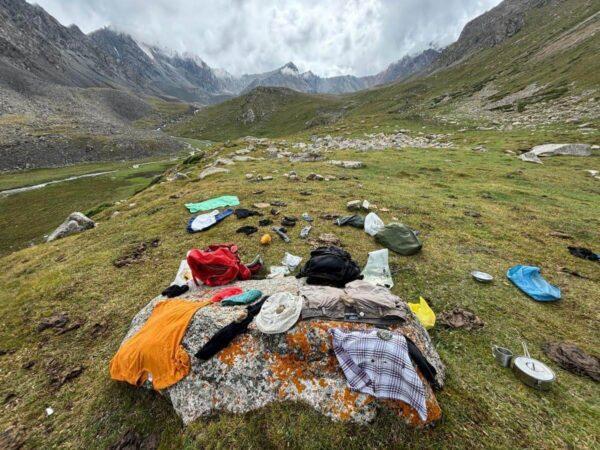
Day #5 Nochlezhka Campground to Altynarasan Camp
After a calm, dry night, we woke up respirited in the mellow morning light. Lingering over breakfast, we watched a large herd of horses grazing with calm indifference around us before setting off on our descent.
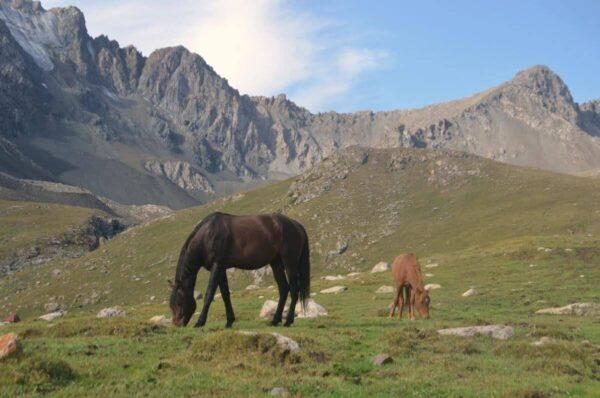
The number of horses we saw carrying tourists in files up the mountain could have formed an entire cavalry regiment. These daily processions had turned the trails into a mix of churned mud and dung. At one point, we had to ford a river, wading through it barefoot. While lacing our shoes back on the opposite shore, we noticed a weasel darting around briskly. She moved with sharp purpose, sneaking into bushes and poking her head over rocks in an attempt to approach some unsuspecting bird.
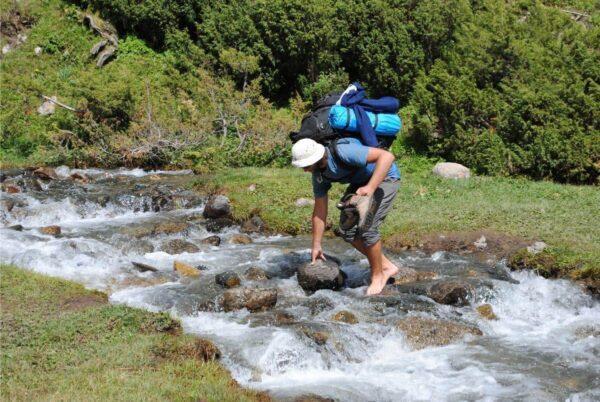
After crossing another river on a trunk bridge, we reached the bottom of the main valley. A little farther along muddy—sometimes knee-deep—trails, we arrived at Altynarasan Camp by around noon. Nestled among rolling alpine meadows, jagged peaks, and the soothing murmur of mountain streams, the camp is a major hub for trekkers exploring the area. True to its name, meaning “Golden Spring” in Kyrgyz, it’s renowned for its natural hot springs. The site offered numerous yurts for rent, as well as rooms in a couple of cozy huts, making it an inviting retreat for weary travelers like ourselves.
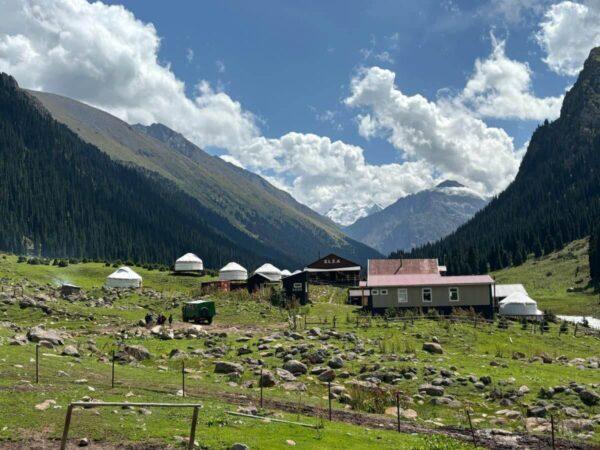
We enjoyed a drink in one of the huts and then pitched our tent on a scenic spot overlooking the camp. Later in the afternoon, we soaked in a burning-hot, sulfuric spring. The small pool was housed inside a shabby hovel and operated on a turn-based schedule. To secure our time, we had to sign up hours in advance and pay 200 som at one of the huts. While waiting for our turn, we had a beer with a German couple at the hut. Though brief, the bath was perfect for relaxing us before sleep.
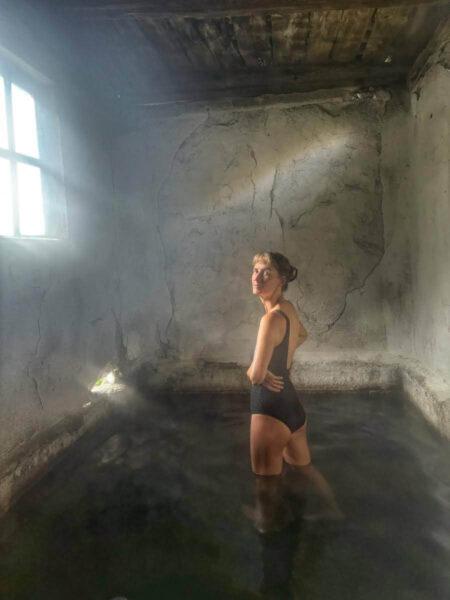
Day #6 Altynarasan Camp to Ak-Suu
And then dawned the last day of this memorable adventure. Off-road taxis were available at the camp, but we preferred to continue on foot until the village of Ak-Suu, where we could take a bus back to Karakol. We clipped down the road, covering the 15 km in just about 3 hours.
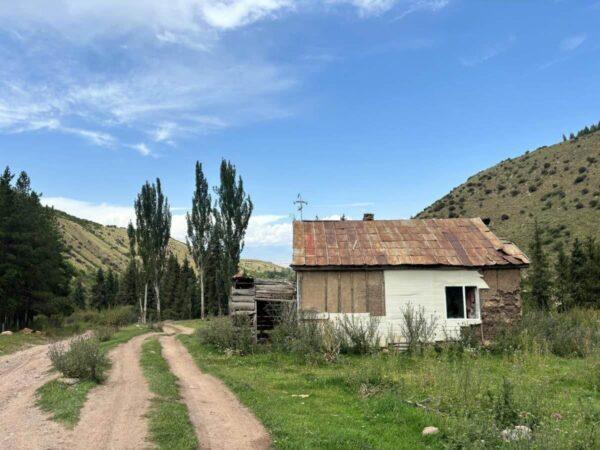
Shortly before reaching the bus stop, we came across an elderly woman who had fallen into the bushes. She was injured and unable to get up. We helped her to her feet—a small good deed to end our day.
After a long wait, no bus showed up. We called a Yandex taxi together with three more travelers who waited concurrently with us The driver didn’t mind all five of us squeezing into his car.
We then spent two nights in Karakol to recover, and continued our trip in Kyrgyzstan with a stop at the beach town of Cholpon Ata and a two-day horse trek to the pristine Son-Kul Lake.
Accommodation and activities in Kyrgyzstan
Stay22 is a handy tool that lets you search for and compare stays and experiences across multiple platforms on the same neat, interactive map. Hover over the listings to see the details. Click on the top-right settings icon to adjust your preferences; switch between hotels, experiences, or restaurants; and activate clever map overlays displaying information like transit lines or concentrations of sights. Click on the Show List button for the listings to appear in a list format. Booking via this map, I will be earning a small cut of the platform's profit without you being charged any extra penny. You will be thus greatly helping me to maintain and keep enriching this website. Thanks!
Photos
View (and if you want use) all my photographs from Ala-Kul in higher resolution.
